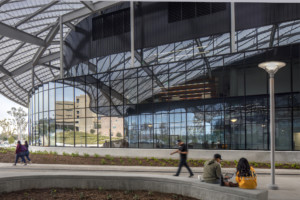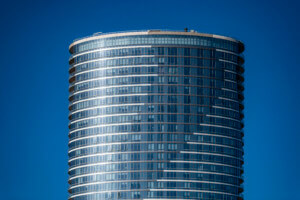In the age of glass curtain walls, the notion of a ‘window‘ may seem a quaint relic of stone and wood framed structures, yet it is still a basic conceptual building block of architecture. In Elements of Architecture, the 2014 Venice Architecture Biennale, Rem Koolhaas installed a large display of glazed windows (pointed arches, wood frames and divided lights) taken from buildings that form the Brooking National Collection of historic building components. Across the room was a display of advanced contemporary windows cut away to show their internal structures, gauges for testing window strength and a machine for making window parts. The idea of these fragments and the 2014 biennale was to suggest they represented advanced “research” into the basic components of contemporary production. But at least with windows it was little more than a formal display of objects, rather than an outline of current academic research or technical sophistication.
But now there is an institute in Tokyo devoting itself solely to the history, meaning and future of the window. Founded by the Japanese fastener (and yes zipper) company YKK AP Inc. in 2007, the Window Research Institute or as they term it “Windowology,” is hoping to become the world–class center for research on glazed openings and an archive of research for scholars. They have, under their director Kinuko Yamamoto, created an institute based on the belief that “windows represent civilization and culture.” It approaches the subject of windows in a serious, academic way that brings in architects, cultural historians, and artists.
It is fascinating that Japan, only a few centuries ago, did not even have framed windows in their buildings but instead utilized paneled Shoji screens that emitted light though the entire wall rather than simple glazed openings. Windows were not introduced into Japan on a large scale until the arrival of Europeans in the 18th century.
The YKK AP–sponsored institute just conducted a day–long symposium on Windowology at the Fumihiko Maki–designed Spiral Hall in conjunction with an exhibition Windows Represent Civilization and Culture, that focuses on the meaning as well as the architectural and urban effects of the window. The exhibition has been organized with the aim of comprehensively examining the knowledge and sensibilities surrounding the window “as a universal cultural phenomena” as described by artists and architects.
Many of the images in the exhibit are based on the institute’s research and highlight the window’s urban effect on the street or as cultural frames for viewing out through and onto the landscape. One large installation, “Window and Ladder–Leaning into History,” by Argentinian artist Leandro Erlich, set the stage by presenting a large gravity–defying window with a ladder in a large double height circular space. In addition, artists Takashi Homma and Yusuke Kamata each presented new window-themed artwork that they created for the exhibition. Finally, Italian architect Michele De Lucchi produced several of his signature pictograms of windows that serve as a poster image of the exhibit.
The symposium presented research by scholars and architects who in their practice consider the importance of the window. Iwan Baan, the architectural photographer, presented a series of windows from refuges camps that are part of a research project he has been developing for ten years. One image showed the mud wall of a camp that had the side of an automobile embedded in it for structural support and used the car’s window opening of the interior space.
Yoshiharu Tsukamoto of Atelier Bow-Wow spoke about windows as adaptations of local cultural norms and environments, arguing that architects must consider these functions as pro forma realities while working with new and advanced technological window design.
Tsukamoto also spoke about energy efficiency in new windows and how they will change our architecture. He described technologically–sophisticated new windows being developed that “pull” heat from the outside into the interior. Fumihiko Maki also focused on the future of technologically–engineered apertures as he spoke about his latest housing projects to create a sustainable society. Three Tokyo–based designers of small residential projects that Tokyo is known for: Yuichiro Kodama, Toshiharu Ikaga and Tetsu Kubota (moderated by Toshiharu Ikaga) discussed wall openings not simply as places for egress or controlled ventilation but as key design elements of each building, like the Steel house, which has an elegant continuous opening on each wall. Finally, historian–designer Terunobu Fujimori showed his wildly expressionistic Mosaic Tile Museum that uses windows as random and odd–shaped small openings splayed across his façade.
The ten–hour symposium also considered the historic legacy of windows in literature, art and regional cultures. Vittorio Lampugnani, who has worked with the YKK AP Institute since it was founded, highlighted Roman paintings of windows found in excavation sites and in the paintings of Caravaggio, where the window became a sign of regional culture but does not emit light in order to emphasize that light comes down from God, not the wall apertures on his painted architecture. Lampugnani also showed his Zurich housing development, where windows serve as traditional markers for European urbanism and historical context.
The YKK AP Institute that created the window event and exhibit is creating an online archive of windows for scholars that makes it the most important repository on window research in the world. Windows may be new to Japanese culture but this Institute is quickly becoming the most important repository of their history, meaning, and development. If you need to know about windows, an important but often overlooked aspect of architecture. you need to go to Windowology.










